Ye Zhou
ForaNav: Insect-inspired Online Target-oriented Navigation for MAVs in Tree Plantations
Mar 04, 2025Abstract:Autonomous Micro Air Vehicles (MAVs) are becoming essential in precision agriculture to enhance efficiency and reduce labor costs through targeted, real-time operations. However, existing unmanned systems often rely on GPS-based navigation, which is prone to inaccuracies in rural areas and limits flight paths to predefined routes, resulting in operational inefficiencies. To address these challenges, this paper presents ForaNav, an insect-inspired navigation strategy for autonomous navigation in plantations. The proposed method employs an enhanced Histogram of Oriented Gradient (HOG)-based tree detection approach, integrating hue-saturation histograms and global HOG feature variance with hierarchical HOG extraction to distinguish oil palm trees from visually similar objects. Inspired by insect foraging behavior, the MAV dynamically adjusts its path based on detected trees and employs a recovery mechanism to stay on course if a target is temporarily lost. We demonstrate that our detection method generalizes well to different tree types while maintaining lower CPU usage, lower temperature, and higher FPS than lightweight deep learning models, making it well-suited for real-time applications. Flight test results across diverse real-world scenarios show that the MAV successfully detects and approaches all trees without prior tree location, validating its effectiveness for agricultural automation.
A Comprehensive Review on Tree Detection Methods Using Point Cloud and Aerial Imagery from Unmanned Aerial Vehicles
Oct 07, 2023Abstract:Unmanned Aerial Vehicles (UAVs) are considered cutting-edge technology with highly cost-effective and flexible usage scenarios. Although many papers have reviewed the application of UAVs in agriculture, the review of the application for tree detection is still insufficient. This paper focuses on tree detection methods applied to UAV data collected by UAVs. There are two kinds of data, the point cloud and the images, which are acquired by the Light Detection and Ranging (LiDAR) sensor and camera, respectively. Among the detection methods using point-cloud data, this paper mainly classifies these methods according to LiDAR and Digital Aerial Photography (DAP). For the detection methods using images directly, this paper reviews these methods by whether or not to use the Deep Learning (DL) method. Our review concludes and analyses the comparison and combination between the application of LiDAR-based and DAP-based point cloud data. The performance, relative merits, and application fields of the methods are also introduced. Meanwhile, this review counts the number of tree detection studies using different methods in recent years. From our statics, the detection task using DL methods on the image has become a mainstream trend as the number of DL-based detection researches increases to 45% of the total number of tree detection studies up to 2022. As a result, this review could help and guide researchers who want to carry out tree detection on specific forests and for farmers to use UAVs in managing agriculture production.
Incremental Nonlinear Dynamic Inversion based Optical Flow Control for Flying Robots: An Efficient Data-driven Approach
Jul 06, 2023Abstract:This paper presents a novel approach for optical flow control of Micro Air Vehicles (MAVs). The task is challenging due to the nonlinearity of optical flow observables. Our proposed Incremental Nonlinear Dynamic Inversion (INDI) control scheme incorporates an efficient data-driven method to address the nonlinearity. It directly estimates the inverse of the time-varying control effectiveness in real-time, eliminating the need for the constant assumption and avoiding high computation in traditional INDI. This approach effectively handles fast-changing system dynamics commonly encountered in optical flow control, particularly height-dependent changes. We demonstrate the robustness and efficiency of the proposed control scheme in numerical simulations and also real-world flight tests: multiple landings of an MAV on a static and flat surface with various tracking setpoints, hovering and landings on moving and undulating surfaces. Despite being challenged with the presence of noisy optical flow estimates and the lateral and vertical movement of the landing surfaces, the MAV is able to successfully track or land on the surface with an exponential decay of both height and vertical velocity at almost the same time, as desired.
Rethinking Soft Labels for Knowledge Distillation: A Bias-Variance Tradeoff Perspective
Feb 01, 2021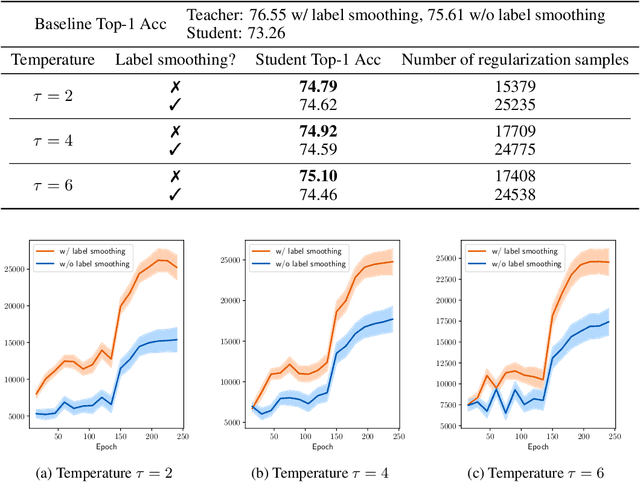


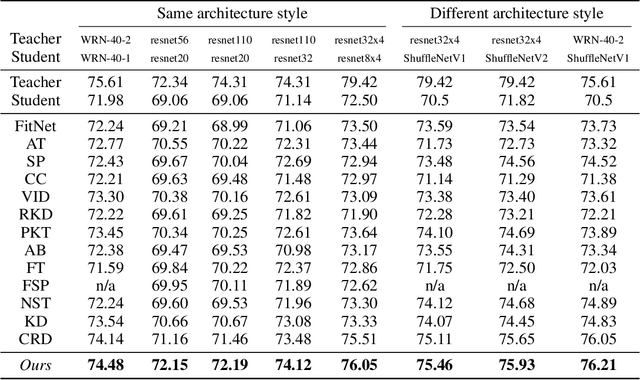
Abstract:Knowledge distillation is an effective approach to leverage a well-trained network or an ensemble of them, named as the teacher, to guide the training of a student network. The outputs from the teacher network are used as soft labels for supervising the training of a new network. Recent studies \citep{muller2019does,yuan2020revisiting} revealed an intriguing property of the soft labels that making labels soft serves as a good regularization to the student network. From the perspective of statistical learning, regularization aims to reduce the variance, however how bias and variance change is not clear for training with soft labels. In this paper, we investigate the bias-variance tradeoff brought by distillation with soft labels. Specifically, we observe that during training the bias-variance tradeoff varies sample-wisely. Further, under the same distillation temperature setting, we observe that the distillation performance is negatively associated with the number of some specific samples, which are named as regularization samples since these samples lead to bias increasing and variance decreasing. Nevertheless, we empirically find that completely filtering out regularization samples also deteriorates distillation performance. Our discoveries inspired us to propose the novel weighted soft labels to help the network adaptively handle the sample-wise bias-variance tradeoff. Experiments on standard evaluation benchmarks validate the effectiveness of our method. Our code is available at \url{https://github.com/bellymonster/Weighted-Soft-Label-Distillation}.
Cryo-ZSSR: multiple-image super-resolution based on deep internal learning
Nov 22, 2020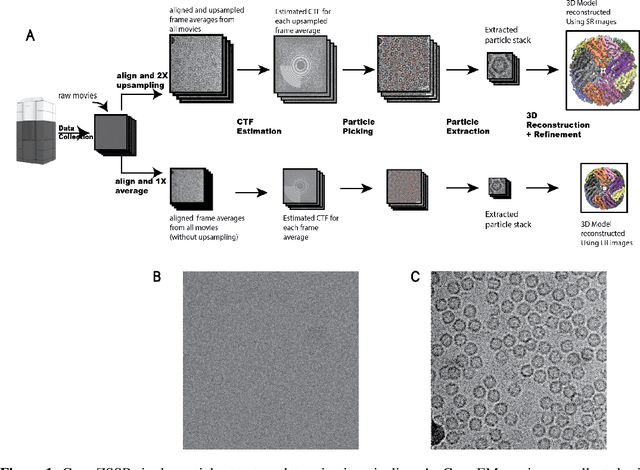
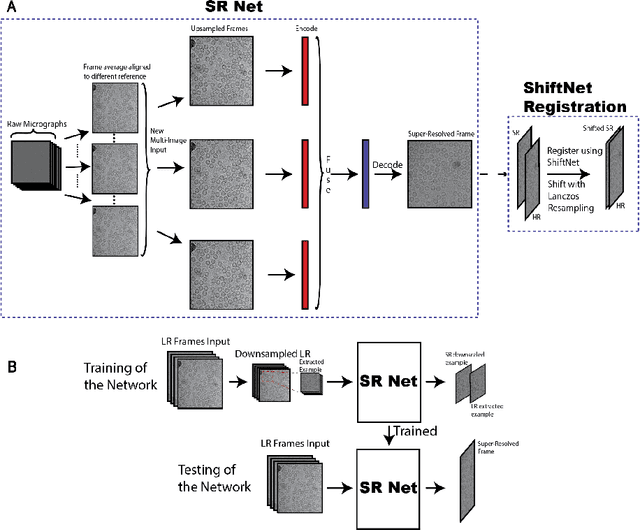
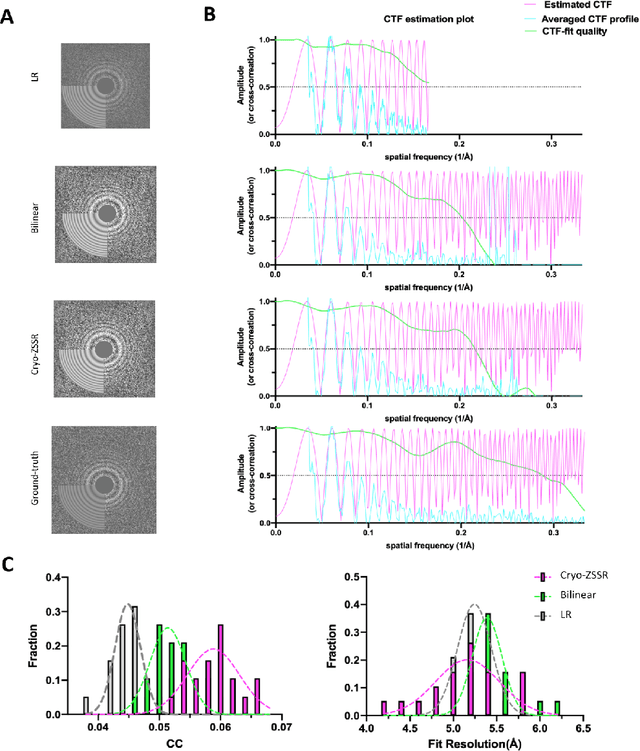
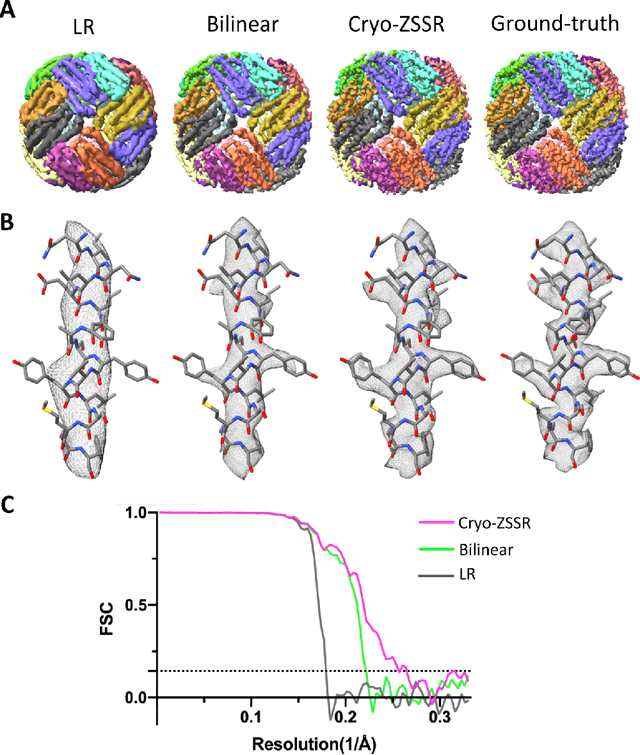
Abstract:Single-particle cryo-electron microscopy (cryo-EM) is an emerging imaging modality capable of visualizing proteins and macro-molecular complexes at near-atomic resolution. The low electron-doses used to prevent sample radiation damage, result in images where the power of the noise is 100 times greater than the power of the signal. To overcome the low-SNRs, hundreds of thousands of particle projections acquired over several days of data collection are averaged in 3D to determine the structure of interest. Meanwhile, recent image super-resolution (SR) techniques based on neural networks have shown state of the art performance on natural images. Building on these advances, we present a multiple-image SR algorithm based on deep internal learning designed specifically to work under low-SNR conditions. Our approach leverages the internal image statistics of cryo-EM movies and does not require training on ground-truth data. When applied to a single-particle dataset of apoferritin, we show that the resolution of 3D structures obtained from SR micrographs can surpass the limits imposed by the imaging system. Our results indicate that the combination of low magnification imaging with image SR has the potential to accelerate cryo-EM data collection without sacrificing resolution.
Unsupervised particle sorting for high-resolution single-particle cryo-EM
Oct 22, 2019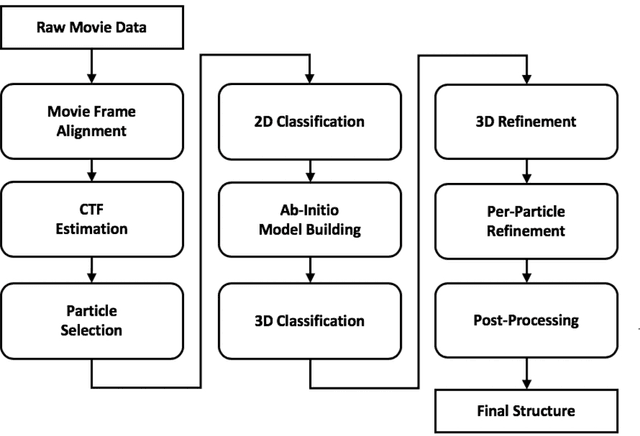
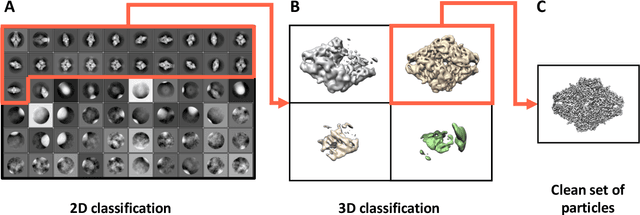
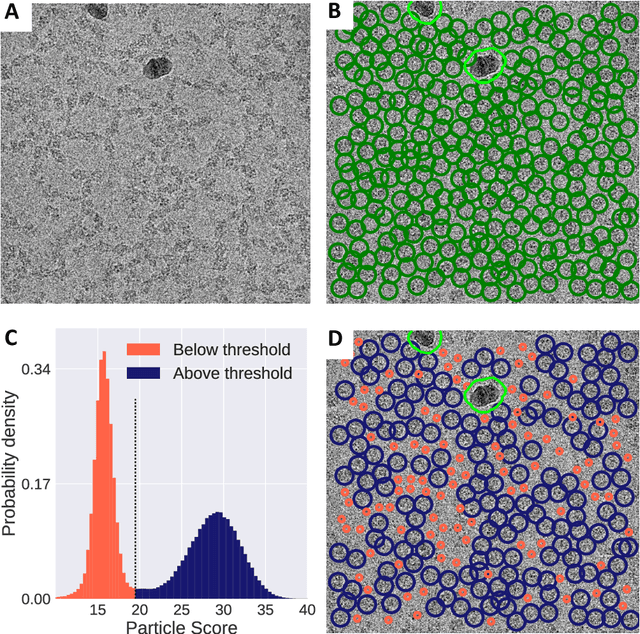
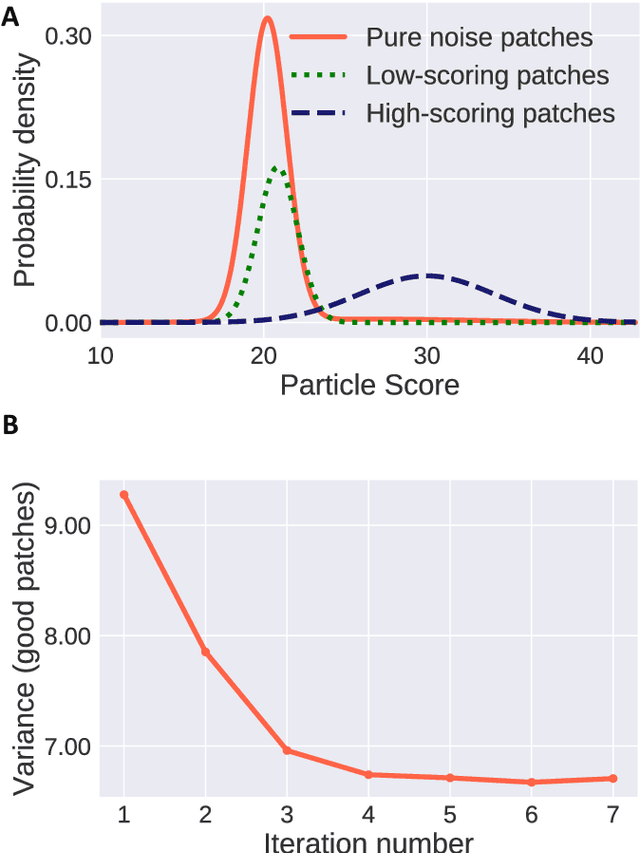
Abstract:Single-particle cryo-Electron Microscopy (EM) has become a popular technique for determining the structure of challenging biomolecules that are inaccessible to other technologies. Recent advances in automation, both in data collection and data processing, have significantly lowered the barrier for non-expert users to successfully execute the structure determination workflow. Many critical data processing steps, however, still require expert user intervention in order to converge to the correct high-resolution structure. In particular, strategies to identify homogeneous populations of particles rely heavily on subjective criteria that are not always consistent or reproducible among different users. Here, we explore the use of unsupervised strategies for particle sorting that are compatible with the autonomous operation of the image processing pipeline. More specifically, we show that particles can be successfully sorted based on a simple statistical model for the distribution of scores assigned during refinement. This represents an important step towards the development of automated workflows for protein structure determination using single-particle cryo-EM.
 Add to Chrome
Add to Chrome Add to Firefox
Add to Firefox Add to Edge
Add to Edge